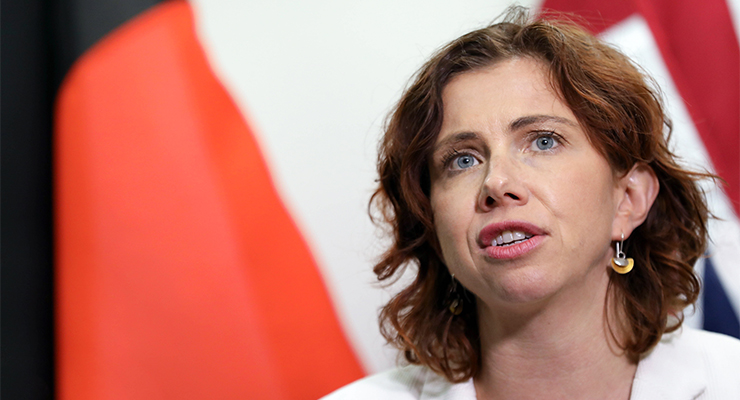
Australia’s National Plan to End Violence against Women and Children has been unveiled today, aiming to end gender-based violence within one generation. All states and territories have now signed on to the 10-year plan, which focuses on four indicators: prevention, early intervention, response and recovery.
It’s the first time a government has made a specific commitment to recovery, addressing the lifelong impacts of gender-based violence, and the impact that exposure to violence has on children. It also examines how lack of housing, low literacy levels and language barriers inhibit victims from accessing help.
A standalone plan for Indigenous and Torres Strait Islander women and children will also be developed.
Men’s relationships are also a focus of the plan, calling for men to develop “healthy masculinities” and healthy relationships with peers, build skills to be good fathers, and encourage them to challenge sexism and harassment as bystanders.
The plan has been called “world-leading” for its focus on recovery, along with its spotlight on addressing attitudes that impact men’s behaviour. But clear targets and measurements are still missing, which was a key criticism of the previous plan.
As stated in the plan, Australia’s data on gender-based violence is muddy, with differences in definitions across jurisdictions and poor statistics on how the LGBTIQA+ and First Nations communities are impacted.
“Currently, data and data-sharing mechanisms are inadequate to provide quality measurements in relation to outcomes for victim-survivors and holding people who choose to use violence to account,” the report states.
The plan seeks to implement new data collections and development projects to track changes over the life of the plan.
Minister for Social Services Amanda Rishworth has said the plan will be accompanied by an “outcomes framework”, with different indicators embedded and measured with available data, but stopped short of calling them targets.
“We could say we’re going to measure things, but if we don’t actually have access to the data, whether it’s from the Commonwealth level, states and territories, then we won’t know if we’re making progress,” she said on ABC News this morning.
The cost of violence against women and children is estimated to be $26 billion a year (though this only includes gender-based violence: the report states if all violence against children were included the cost would be significantly higher).
Last year’s budget promised $1.3 billion across six years for the plan’s first phase to address family, domestic and sexual violence, and Labor has committed to ensuring this money is properly targeted. However, it has not announced an increase in funding ahead of this month’s budget.








How about we start by stopping glorification of violence? Could we perhaps do with less UFC advertising / reporting / broadcasting on TV?
I’m not a fan of the UFC but it’s participants train in order to get involved, they are paid for their involvement and the power differentials are those of experience and skill. That’s a long way from the Cycle of Violence and the entrenched power imbalances encouraged and supported to keep women unsafe in our society.
So what exactly are we supposed to measure, then?
I mean if you independently count up the number of hospitalisations of Indigenous women and children (using admission data, say), that’s a pretty clear and unambiguous number, giving a fairly concrete empirical picture: ie that this demographic cohort is subject to hospital-level physical violence at x times the average rate.
If on the other hand you count up the number of self-selecting respondents who answer ‘yes’ to a survey of parliament house staff which offers a widely varying range of ‘DV’ types, and also offers several different systemic avenues for responding but doesn’t combine one single respondent’s multiple duplicate citations of their experiences when ‘totalling up’ the ‘data’….to get the much-quoted ‘1 in 3’ figure of the Jenkins Report…what exactly is that ‘measurement’ telling us, really?
What… that is useful in triaging and targeting the problem efficiently and honestly, I mean.
If we want to reduce DV then the first thing the now Highly Monetised & Professionalised Big DV sector needs to do is get serious about their own number collecting, collating, categorising and crunching. I think, anyway.
Yes, that would be true if the Jenkins report was the only one that suggested that 1 in 3 women are likely to be victims of men’s violence, but it’s pretty much a worldwide figure that only gets worse in some spaces. There are few spaces where women live actual or perceived safer loved than that. And considering that violence against women is under reported not over reported, as you seem to imply, many fewer women love safer lives than you’d like to think, whatever the arena.
How about we also address some other systemic causes like the normalisation of violence as ‘entertainment’ (real violence is sickening, it has to be sanitised to entertain) and the dog-eat-dog social values brought to us by a generation and a half of neoliberalism.
I’d vote for that – which party is offering such a major reform of reality?
Come back Lysistrata, you are needed.
Yet again.
As if. She’s probably busy googling to see who she can plagiarise to make out like she knows what she’s talking about. As always.
So maybe we will see less woman’s boxing on Foxtel?
While violence is premium entertainment (yes Foxtel Main Event is a problem), Hollywood continues to glorify violence and doesn’t get threatened with an all out ban.
First move ban all violent sports, no this is not a reasonable outlet for those who need it, they need psychological help. Violence should be unacceptable
Pressure the IOC and similar bodies to ban violent sports, they are not sports, they are violence.
Bring similar restrictions on violence in movies as applied to sex, sex it is possible some one could consent to is far more restricted than somebody getting beaten to a pulp. I doubt anyone would consent to M rated Hollywood violence.
Then you can look at reducing violence in in society